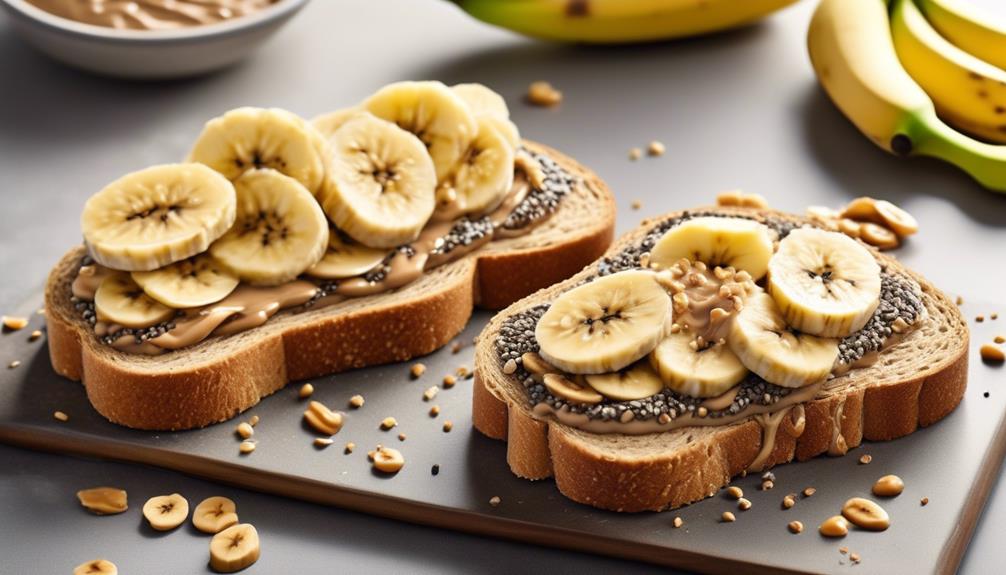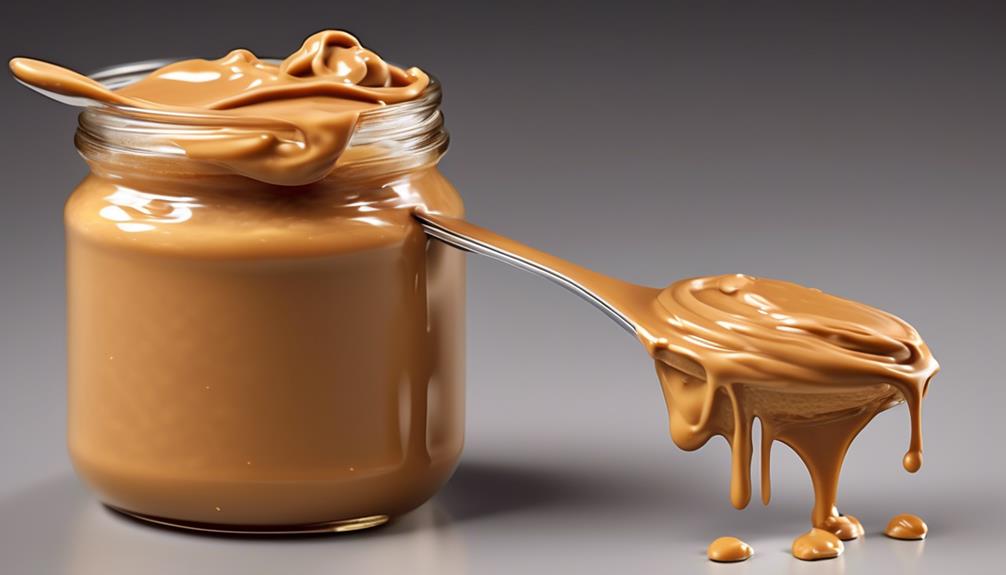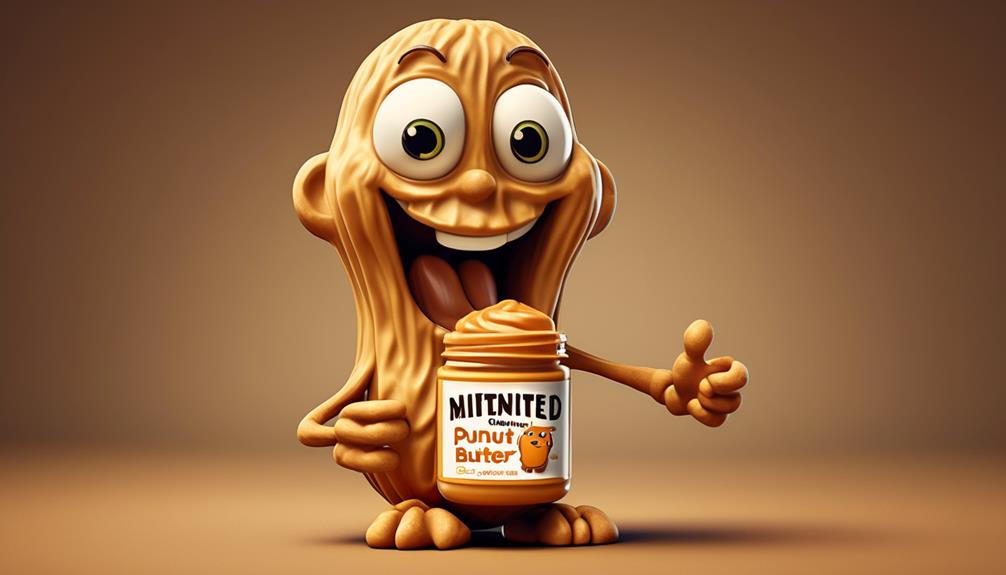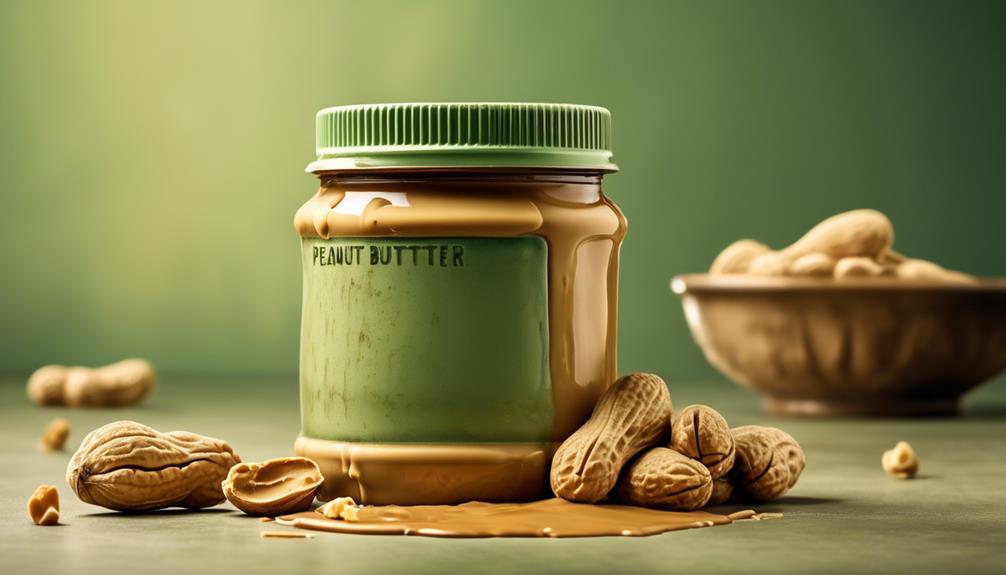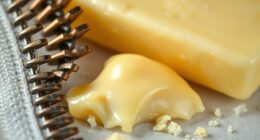We have all experienced the annoyance of having to separate from certain items before getting on a plane. One particular item that frequently causes confusion is peanut butter. The ban on bringing peanut butter in carry-on luggage has puzzled many travelers. It is just a seemingly harmless spread, so why the limitation?
Well, let's just say it all comes down to a rather unexpected classification by the Transportation Security Administration (TSA). But there's more to this story, and it's not just about its status as a liquid.
Key Takeaways
- Peanut butter is classified as a liquid by the TSA and is subject to the 3.4-ounce limit for carry-on bags.
- The primary concerns regarding peanut butter on planes are potential contamination, spreading hazards, and security breaches.
- Peanut butter can pose a flammability risk due to the oils in it, and regulations are in place to mitigate this hazard.
- Airlines must find alternative spreads or snacks for in-flight meals due to restrictions on peanut butter, and compliance with regulations is crucial for passenger safety.
Airborne Allergen Concerns
In light of heightened awareness about airborne allergens, it's crucial for air travel regulations to address the potential risks and ensure the safety of all passengers. The Transportation Security Administration (TSA) has strict regulations regarding the carrying of peanut butter as it's considered a liquid. The 3.4-ounce limit for liquids in carry-on bags applies to peanut butter and frosting. This attention to detail by airport security aims to minimize the risk of allergic reactions caused by airborne allergens, ensuring a safer environment for all travelers.
Furthermore, the concerns extend beyond passenger consumables. While dry pet food and snacks are allowed in carry-on bags, liquid-y pet food is prohibited due to similar considerations. The TSA also restricts high-proof alcohol from carry-on bags, aligning with the overarching goal of minimizing potential airborne allergen hazards.
In the case of passengers with peanut allergies, airlines have responded by allowing them to inform the airline in advance. Some airlines may even establish buffer zones around affected passengers to mitigate exposure to peanut allergens. These measures reflect a commitment to regulatory compliance and a thoughtful approach to addressing airborne allergen concerns in air travel.
Potential for Contamination

We must consider the potential for peanut butter to spill or spread, leading to contamination of other items in the carry-on bag.
This poses a significant health and safety concern, particularly for passengers with allergies or sensitivities.
It's crucial to adhere to TSA regulations and take measures to prevent the spread of hazards, ensuring a safe and secure travel environment for all passengers.
Allergen Risk
With the potential for severe allergic reactions from even trace amounts of allergens, the risk of cross-contact must be meticulously addressed in the handling of allergen-containing food items such as peanut butter in shared environments like airline catering and in-flight services. Our attention to detail in managing allergen risk is paramount to ensure the safety of all passengers.
When dealing with peanut butter, we prioritize regulatory compliance and implement strict protocols to prevent cross-contact and allergen contamination. Our analytical mindset drives us to continually assess and improve our processes to minimize the risk of allergen exposure.
Security Concerns
Amid our rigorous approach to regulatory compliance and attention to detail, we meticulously address the potential for contamination when it comes to the security concerns surrounding peanut butter in air travel.
Security concerns arise due to the classification of peanut butter as a liquid by the TSA, leading to the 3.4-ounce limitation for carry-on bags. This categorization is based on the potential for peanut butter to spread, pour, or spill, posing security risks.
Our analytical mindset ensures that we adhere to TSA regulations, recognizing the importance of maintaining a secure environment for all passengers. By treating peanut butter as a liquid, we mitigate the potential for security breaches, demonstrating our commitment to addressing even the smallest details when it comes to air travel security concerns.
Spreading Hazards
When it comes to the risk of spreading hazards and potential contamination of peanut butter and frosting on planes, the following measures are in place:
- Liquid Limit: Peanut butter and frosting are subject to the 3.4-ounce limit for carry-on bags, as they must comply with the liquids rule due to their potential for spreading and contamination.
- Spillage Risk: Liquids have no definite shape and take the shape of their container, posing a risk of spillage and spreading, which is a primary concern for peanut butter and frosting.
- TSA Classification: The TSA classifies frosting as a condensed syrup falling under the liquids category, thus subjecting it to the same restrictions as other liquid items.
- Regulatory Compliance: Maintaining strict adherence to the liquids rule is essential for preventing potential spreading hazards and ensuring air travel safety.
These measures are crucial in addressing the potential for contamination and spreading hazards associated with peanut butter and frosting during air travel.
Security Screening Challenges

As travelers, we must be mindful of the liquid restrictions set by the TSA, especially when it comes to unconventional items like peanut butter and frosting.
Additionally, the potential for allergy concerns and the need to prevent smuggling concealment pose significant security screening challenges.
It's crucial to adhere to regulations and understand the implications of these restrictions to ensure a smooth and compliant travel experience.
Liquid Restrictions
When navigating the stringent liquid restrictions at airport security screenings, it's essential to be mindful of items such as peanut butter and freezer packs, as they're subject to the 3.4-ounce limit for carry-on bags. Here are some key points to consider:
- Peanut butter and frosting are considered liquids by the TSA, so they must adhere to the 3.4-ounce limit for carry-on bags.
- Frozen freezer packs are allowed in carry-on bags, but partially melted or slushy packs are considered liquids and subject to the 3-1-1 rule.
- Alcohol over 140 proof is banned from carry-on bags, regardless of the bottle size.
- When traveling with pets, wet pet food isn't allowed in carry-on bags, so it's advisable to opt for dry food and snacks.
Being mindful of these liquid restrictions can help streamline the security screening process and ensure a hassle-free travel experience.
Allergy Concerns
Considering the potential risks posed by airborne allergens, it's crucial for travelers to be fully informed and compliant with security screening regulations, particularly in relation to allergy concerns.
The TSA's classification of peanut butter as a liquid, subject to the 3.4-ounce limit for carry-on bags, is rooted in allergy concerns. Peanut allergies can be triggered by airborne particles and even the smell of peanuts, making it essential for measures to be in place to minimize exposure.
Airlines often allow passengers with peanut allergies to pre-inform them of their needs, establishing buffer zones around affected passengers. Furthermore, some airlines have opted to go entirely peanut-free to accommodate passengers with allergies.
Travelers should exercise consideration by avoiding bringing peanut products on board and opting for alternative snacks like cheese, crackers, beef jerky, hummus, or sunbutter, thus contributing to a safer and more inclusive travel experience.
Smuggling Concealment
Given the stringent security measures related to prohibited items such as peanut butter, it's imperative to understand the challenges posed by smuggling concealment during security screenings. When it comes to smuggling concealment, security personnel face the daunting task of detecting various prohibited items.
Here are some of the challenges they encounter:
- Concealment Techniques: Smugglers often resort to creative concealment methods such as hollowing out books, modifying electronic devices, or using hidden compartments in luggage to conceal prohibited items like peanut butter.
- Body Concealment: Individuals may attempt to conceal items on their person, presenting a significant challenge for security personnel during pat-downs and body scans.
- Bulk Packaging: Smugglers may attempt to disguise prohibited items within larger, permissible items, making it difficult to detect during routine screenings.
- Chemical Odor Masking: Some individuals may try to mask the scent of prohibited items like peanut butter with strong chemical odors to evade detection by K-9 units.
Understanding these challenges is crucial for enhancing security measures and preventing the smuggling of prohibited items such as peanut butter.
Flammability and Combustion Risks

Understanding the potential flammability and combustion risks associated with certain items is crucial for ensuring air travel safety.
When it comes to peanut butter, the concern lies in its flammability. While peanut butter itself isn't flammable, the issue arises from the packaging it's typically stored in.
The oils in peanut butter can pose a potential risk if the product isn't securely packaged and stored. If the oils were to leak and come into contact with certain materials, they could contribute to the start or spread of a fire. This risk is especially significant in the confined environment of an aircraft, where any fire could have catastrophic consequences.
As a result, airline and TSA regulations restrict the amount of peanut butter that can be brought onto a plane, and it must be properly packaged to mitigate any potential flammability hazards.
Adhering to these regulations is essential for maintaining the safety of all passengers and crew. It's important to recognize and respect the reasons behind these restrictions to ensure a secure and pleasant air travel experience for everyone.
Impact on In-Flight Meals

The impact of TSA regulations on in-flight meals requires careful consideration to ensure compliance and safety for all passengers.
When it comes to the inclusion of peanut butter in in-flight meals, the following factors must be taken into account:
- Packaging Restrictions: Due to the TSA's 3.4-ounce limit for carry-on liquids, peanut butter can only be included in in-flight meals if it adheres to this restriction. This poses a challenge for airlines in providing substantial servings while complying with the regulations.
- Alternative Options: Given the restrictions on peanut butter, airlines must consider alternative spreads or snacks to offer passengers as part of their in-flight meals. This necessitates a thorough review of available options to ensure both compliance and passenger satisfaction.
- Allergy Considerations: Peanut allergies are prevalent, and the inclusion of peanut butter in in-flight meals can pose a risk to allergic passengers. Careful planning and communication are essential to address these concerns and ensure the safety of all travelers.
- Catering Protocols: Airlines need to work closely with their catering services to ensure that in-flight meals containing peanut butter are handled, stored, and served in a manner that aligns with TSA regulations and safety standards.
Navigating the impact of TSA regulations on in-flight meals, particularly regarding the inclusion of peanut butter, demands meticulous attention to detail and adherence to stringent guidelines for the benefit of all passengers.
International Regulations and Restrictions

Navigating international regulations and restrictions requires a keen understanding of diverse compliance standards and meticulous attention to detail. When traveling internationally, it's crucial to be aware of the specific rules and limitations imposed by different countries.
For instance, the transportation security administration (TSA) in the United States considers certain items like peanut butter and frosting as liquids, subject to the 3.4-ounce limit for carry-on bags, aligning with the international regulations and restrictions. Additionally, frozen freezer packs are allowed in carry-on bags, but partially melted or slushy freezer packs are considered liquids and are subject to the 3-1-1 rule, which is a common standard across various international airports.
Furthermore, international regulations and restrictions also extend to items such as alcohol, sports equipment, and even pet food. For instance, alcohol over 140 proof is banned from carry-on bags, in accordance with global aviation regulations. Understanding and adhering to these regulations is essential to ensure a smooth and hassle-free travel experience.
It's important to stay informed about the specific restrictions of the destination country as well, as these may vary. By remaining attentive to the details of international regulations and restrictions, travelers can navigate the complexities of air travel with confidence and ease.
Historical Incidents and Precedents

Having encountered the intricacies of international regulations and restrictions, we recognize the pivotal importance of delving into historical incidents and precedents to gain deeper insights into the evolution of air travel guidelines and the underlying principles that have shaped them.
- Lessons Learned: Historical incidents involving prohibited items like peanut butter highlight the need for stringent security measures to ensure passenger safety and aviation security.
- Policy Development: Studying past events aids in understanding the rationale behind current regulations, leading to the development of more effective and targeted policies.
- Impact Assessment: Analyzing historical incidents and precedents allows us to assess the impact of past events on the formulation of regulations, providing valuable insights into their effectiveness and potential shortcomings.
- Future Considerations: By examining historical incidents and precedents, we can identify patterns and trends that inform decision-making, ensuring that future policies and practices are shaped by a comprehensive understanding of past experiences.
Analyzing historical incidents and precedents related to peanut butter and air travel enables a thorough understanding of how regulations have evolved and the critical role they play in ensuring the safety and security of air travel.
Passenger Safety Prioritization

Passengers must adhere to strict regulations regarding the classification of certain items as liquids and the specific limitations for carrying them in their bags for the safety and security of air travel. Security prioritization is a key factor in determining what items are permitted in carry-on bags. The Transportation Security Administration (TSA) has established guidelines to ensure the safety of all passengers. Here's a breakdown of some items and their categorization for carry-on bags:
| Item | Classification |
|---|---|
| Peanut Butter | Liquid (subject to 3.4-ounce limit) |
| Frosting | Liquid (subject to 3.4-ounce limit) |
| Frozen Freezer Packs | Allowed (partially melted or slushy ones are considered liquids) |
| Alcohol over 140 proof | Prohibited from carry-on bags |
| Sports Equipment | Certain items allowed in cabin, others must be checked |
| Wet Pet Food | Not allowed in carry-on bags |
Alternative Options for Air Travel Snacks

When preparing for air travel, it's important to consider alternative snack options that comply with TSA regulations and provide sustenance during the journey. Here are some alternative options for air travel snacks that ensure compliance with TSA regulations:
- Frozen Freezer Packs: Use frozen freezer packs in your carry-on bag to keep snacks and drinks cool during air travel. These packs are allowed and can help keep perishable snacks fresh.
- Non-Liquid Snacks: Consider bringing non-liquid snacks such as protein bars, trail mix, or granola bars as alternatives to peanut butter. These snacks are convenient, non-liquid, and comply with TSA regulations.
- Single-Serve Nut Butter Packets: Purchase pre-packaged single-serve nut butter packets that comply with the TSA's 3.4-ounce limit for carry-on bags. This allows you to enjoy the flavor of nut butter without violating TSA regulations.
- Dry Snacks: Opt for dry snacks like pretzels, popcorn, or dried fruits that don't fall under the TSA's liquid restrictions. These snacks are convenient, non-liquid, and TSA-compliant.
Frequently Asked Questions
Why Is Peanut Butter Banned From Airlines?
Peanut butter is banned from airlines because it's classified as a liquid by the TSA, falling under the 3.4-ounce limit for carry-on items. This is due to its ability to take the shape of its container. Similarly, frosting is also considered a liquid. Even though some argue that frosting isn't a gel, the TSA maintains its stance.
It's important to adhere to these regulations to ensure compliance with airline safety protocols.
Why Is Peanut Butter Considered a Liquid?
Why is peanut butter considered a liquid?
Well, the TSA classifies it as such due to its potential to take the shape of its container and spill. This aligns with their 3.4-ounce limit for carry-on liquids.
While some may argue otherwise, the TSA's stance remains unchanged. We understand the frustration, but safety measures are key.
Hopefully, this sheds light on the reasoning behind this classification.
Can I Bring a Peanut Butter Sandwich Through Tsa?
Yes, we can bring a peanut butter sandwich through TSA. As long as the peanut butter is in a container that's 3.4 ounces or less and fits within the quart-sized bag for carry-on liquids, it complies with TSA regulations.
It's important to ensure that the sandwich doesn't contain any other prohibited items and to be mindful of any potential allergen concerns for other passengers.
Is Deodorant Part of the 3-1-1 Rule?
Yes, deodorant is indeed part of the 3-1-1 rule for carry-on bags. It must be in a container of 3.4 ounces or less and placed in a quart-sized, clear, plastic, zip-top bag.
This rule allows each passenger to carry one quart-sized bag of liquids, gels, or aerosols.
However, solid deodorant sticks are exempt from the 3-1-1 rule and can be packed in carry-on bags without restrictions.
Conclusion
In conclusion, it seems that peanut butter's ability to shape-shift and cause havoc in the skies has led to its ban on planes.
While we may miss the convenience of a PB&J sandwich while flying, we can take comfort in knowing that our safety and security are being prioritized.
Perhaps one day, peanut butter will be allowed back on planes, but for now, we'll just have to settle for pretzels.

